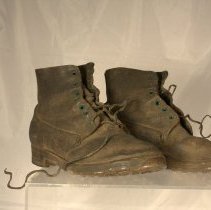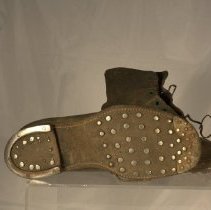Object Record
Images



Metadata
Object Name |
Boot |
Catalog Number |
1982.044.05 |
Description |
Brown leather WWI Pershing boots. Tied open tab with 7 metal eyelet pairs. Stacked heel and the toe has a metal trimming on the bottom and the soles from the toe around to the heel have 6 rows of metal cleats. 1 metal rivet on each side of the shoe. 7 1/2 EE eched on the bottom center of both boots. Above is etched what appears to be No. 14M O M.C. U.S.A. |
Provenance |
Belonged to Elmer George Washington Thiel who was born Feb. 22, 1895 in La Crosse and died July 25th, 1981 in La Crosse. |
Date |
c. 1918 |
Event |
World War I |
Material |
Leather; Metal |
Dimension Details |
7 1/2 EE c.u.s.A. (EE stands for men's wide in western boot sizing) |
Inscription Type |
Inscription |
Inscription Text |
appears to say: No. 14M O M.C. U.S.A. 7 1/2 EE |
Inscription Location |
on the sole |
People |
Thiel, Elmer George Washington |
Subjects |
Military Clothing & Accessories "Things that Matter" |
Search Terms |
World War I WWI "Things that Matter" |
Relation |
Show Related Records... |
Notes |
Pershing Boots were made to be water proof unlike the 1917 trench boots, which could cause trench foot. Featured in Things that Matter Now that mud season is (happily) upon us, have you dug out your best waterproof boots? If last year’s galoshes won’t cut it, consider finding a pair of Pershing boots, like the ones in the La Crosse County Historical Society’s collection. "Oh the ruddy mud, the muddy mud, the mud that gets your goat," wrote Corp. Jack Warren Carrol in a May 1918 edition of The Stars and Stripes. When American forces got to France in 1917 during World War I, they quickly found themselves marching, sleeping and fighting in mud. Battlefields covering dozens of square miles turned into oceans of mud, and men and machines had to slog through it for months on end. U.S. infantry troops quickly discovered that their boots were not up to the task, largely because the leather uppers were not waterproof. We can presume that having cold, wet feet for several days or weeks at a time did nothing for morale. But more importantly, the damp boots were ripe environments for the development of "trench foot," a medical condition that at best hinders a soldier’s fighting ability, and at worst results in amputation. In January 1918, Gen. John J. Pershing, commander of the American Expeditionary Forces, personally cabled the War Department to request a new boot. The result was the Pershing Boot, a larger, sturdier and more waterproof model. Impressed by their size and effectiveness, soldiers called them "Little Tanks." Many years ago, a Wisconsin soldier must have brought these boots home with him. After all, if the Pershing boots could stand up to the muddy fields of France, they should be able to handle a Wisconsin spring. |